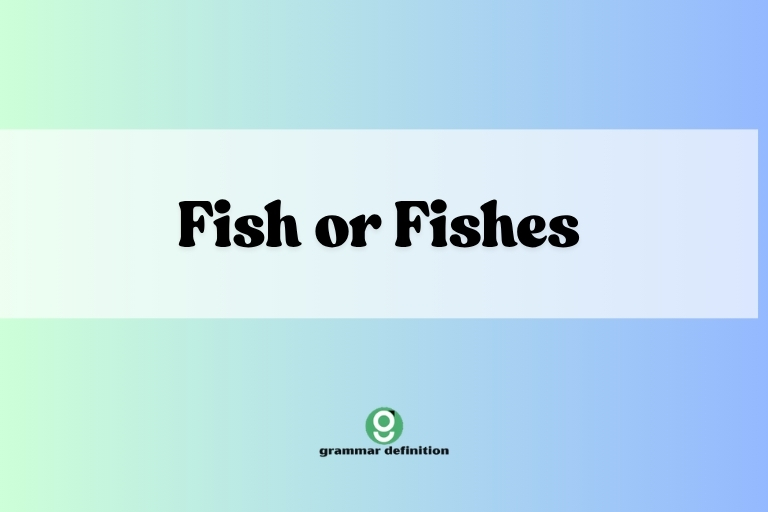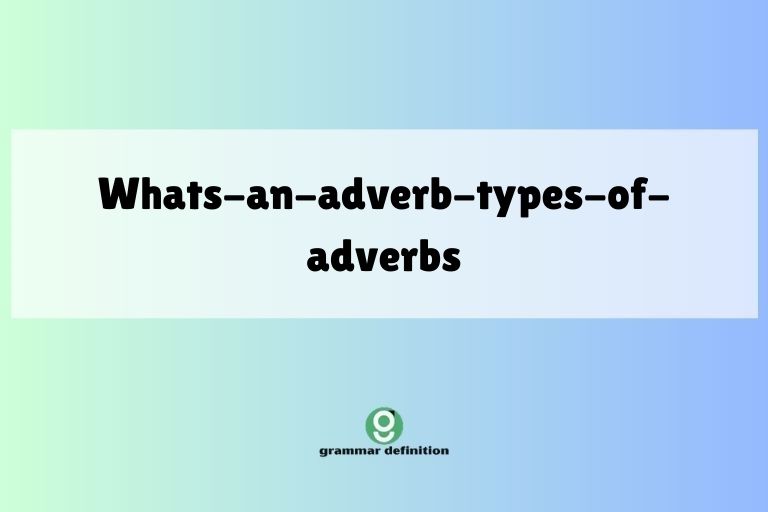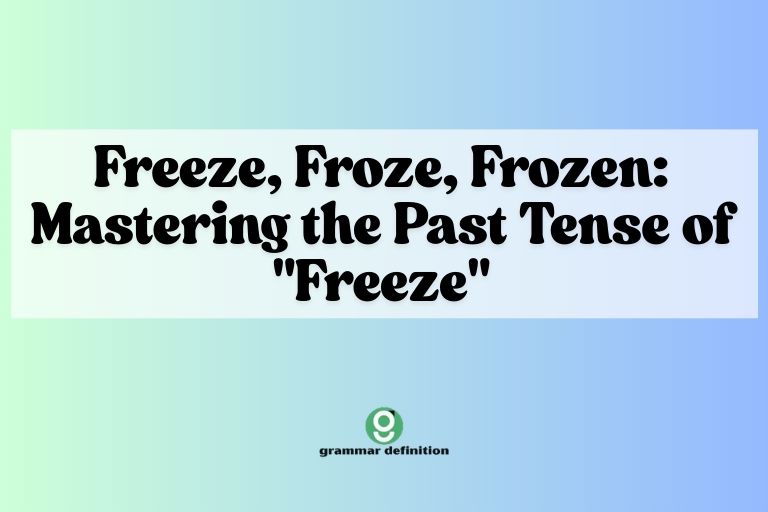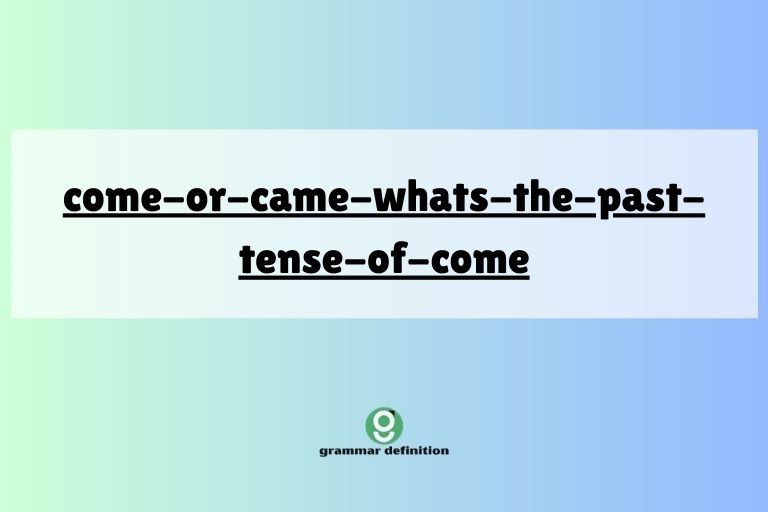Fish or Fishes: Understanding the Plural Forms

The English language is full of quirks, and one of the most common questions among learners is whether the plural of “fish” is “fish” or “fishes.” While both forms are correct, they are used in different contexts. Understanding the nuances of when to use each form is crucial for accurate and effective communication.
This article provides a comprehensive guide to mastering the plural forms of “fish,” covering definitions, usage rules, common mistakes, and practice exercises. Whether you’re a beginner or an advanced learner, this guide will help you confidently navigate this tricky aspect of English grammar.
Table of Contents
- Introduction
- Definition of Fish and Fishes
- Structural Breakdown
- Types and Categories
- Examples of Fish and Fishes
- Usage Rules
- Common Mistakes
- Practice Exercises
- Advanced Topics
- FAQ
- Conclusion
Definition of Fish and Fishes
To understand the difference between “fish” and “fishes,” it’s essential to define each term and explore their specific contexts. The word “fish” can function as both a singular and a plural noun, referring to one or more individuals of the same species.
The word “fishes,” on the other hand, is typically used to refer to multiple species of fish.
Definition of Fish
Fish (singular and plural): Refers to one or more individuals of the same species of fish. It is the more common and widely used plural form. Think of it like “sheep” or “deer,” where the plural form is identical to the singular.
For example, if you catch three trout from a lake, you would say, “I caught three fish.” The focus is on the number of individual creatures, all belonging to the same kind.
Definition of Fishes
Fishes (plural): Refers to multiple species or kinds of fish. This form is less common but essential when you want to emphasize the variety of fish present. It’s used to denote different types or species, rather than just a quantity of the same type.
For instance, if you visit an aquarium and see sharks, clownfish, and eels, you would say, “The aquarium has many different fishes.” Here, the emphasis is on the diversity of species housed in the aquarium.
Structural Breakdown
The structural difference between “fish” and “fishes” lies in the way the plural is formed. “Fish” uses what is known as a zero plural, where the singular and plural forms are the same. “Fishes,” on the other hand, uses the standard English pluralization rule of adding “-es” to the end of the word.
Understanding these structural elements helps clarify when each form is appropriate. The zero plural form of “fish” is deeply ingrained in the English language and is often preferred for its simplicity when referring to a group of the same species.
The “-es” pluralization in “fishes” serves to explicitly indicate multiple types or species.
Types and Categories
The usage of “fish” and “fishes” can be categorized based on the context and the intention of the speaker or writer. These categories help to clarify when each form is most appropriate.
Same Species (Use “Fish”)
When referring to multiple individuals of the same species, the correct plural form is almost always “fish.” This is the most common usage and is applicable in a wide range of situations.
For example, if you are talking about a school of tuna, you would say, “There are many fish in the school.” Similarly, if you are fishing and catch several salmon, you would say, “I caught five fish today.”
Different Species (Use “Fishes”)
When referring to multiple species of fish, the preferred plural form is “fishes.” This usage emphasizes the variety of different kinds of fish present.
For instance, a marine biologist studying a coral reef might say, “The reef is home to a diverse array of fishes.” Similarly, a pet store owner might say, “We sell a variety of tropical fishes.”
Scientific Context (Either Form)
In scientific contexts, both “fish” and “fishes” can be used, but “fishes” is generally preferred when discussing different taxa (groups) of fish. However, “fish” is still acceptable, particularly in more general scientific discussions.
For example, a scientific paper might state, “The study examined the impact of pollution on several fishes.” Alternatively, a researcher might say, “We are studying the behavior of fish in this ecosystem.”
Examples of Fish and Fishes
To further illustrate the proper usage of “fish” and “fishes,” here are several examples categorized by context. These examples will help solidify your understanding of when to use each form correctly.
Examples Using “Fish”
The following table provides examples of using “fish” as the plural form when referring to the same species.
| Sentence | Context |
|---|---|
| I saw a school of fish swimming in the ocean. | Describing marine life |
| He caught three fish on his fishing trip. | Fishing activity |
| The restaurant serves fresh fish every day. | Dining and cuisine |
| We need more fish for the aquarium. | Aquarium maintenance |
| The fisherman hauled in a net full of fish. | Commercial fishing |
| The cat loves to eat fish. | Pet’s diet |
| There are many colorful fish in the coral reef. | Marine ecosystem |
| She bought some fish at the market. | Grocery shopping |
| The lake is stocked with fish every spring. | Lake management |
| He released the fish back into the river. | Catch and release |
| The recipe calls for two pounds of fish. | Cooking instructions |
| The children enjoyed feeding the fish at the pond. | Recreational activity |
| The biologist is studying the migration patterns of fish. | Scientific research |
| The pond is full of small fish. | Pond ecosystem |
| The aquarium has a variety of fish from around the world. | Aquarium exhibit |
| The chef prepared a delicious fish dish. | Culinary arts |
| He is learning how to fillet fish. | Cooking skill |
| The painting depicts a school of fish. | Artistic representation |
| The documentary showed the life cycle of fish. | Educational film |
| Many fish are affected by pollution. | Environmental issue |
| I grilled some fish for dinner last night. | Meal preparation |
| He went to the pet store to buy more fish food. | Pet care |
| The local stream is known for its trout fish. | Regional specialty |
| The fisherman uses a special net to catch fish. | Fishing equipment |
| The lake is home to many different types of fish. | Lake ecosystem |
Examples Using “Fishes”
The following table provides examples of using “fishes” as the plural form when referring to different species.
| Sentence | Context |
|---|---|
| The scientist studied the diverse group of fishes in the Amazon River. | Scientific research |
| The aquarium showcased a variety of colorful fishes from around the world. | Aquarium exhibit |
| The marine biologist identified several new fishes during the expedition. | Marine biology |
| The book described the different families of fishes found in the ocean. | Educational material |
| The pet store sells a wide selection of tropical fishes. | Retail business |
| The exhibit featured fishes of the Great Barrier Reef. | Museum exhibit |
| The documentary explored the evolution of fishes over millions of years. | Educational film |
| The research project focused on the genetic diversity of fishes. | Scientific study |
| The conference discussed the conservation of endangered fishes. | Environmental conservation |
| The museum has a large collection of preserved fishes. | Museum collection |
| The report detailed the impact of climate change on various fishes. | Environmental report |
| The seminar covered the taxonomy and classification of fishes. | Educational seminar |
| The study compared the feeding habits of different fishes. | Scientific research |
| The naturalist observed several rare fishes in the remote lake. | Naturalist observation |
| The publication listed the various species of fishes found in the region. | Scientific publication |
| The gallery displayed paintings of exotic fishes. | Art gallery |
| The lecture focused on the adaptations of deep-sea fishes. | Educational lecture |
| The experiment tested the effects of pollution on different fishes. | Scientific experiment |
| The article described the unique characteristics of freshwater fishes. | Scientific article |
| The survey identified the most common fishes in the area. | Ecological survey |
| The aquarium is home to a diverse collection of fishes. | Aquarium exhibit |
| The project studied the migration patterns of different fishes. | Research project |
| The exhibition showcased the beauty of coral reef fishes. | Art exhibition |
| The research team documented the various types of fishes in the river. | Research documentation |
| The program educated the public about the importance of protecting fishes. | Educational program |
Examples in Scientific Contexts
Below are examples illustrating the use of “fish” and “fishes” in scientific contexts.
| Sentence | Context |
|---|---|
| The study examined the impact of pollution on several fishes. | Scientific research (emphasizing different species) |
| We are studying the behavior of fish in this ecosystem. | General scientific discussion |
| The researchers analyzed the DNA of various fishes to determine their evolutionary relationships. | Scientific research (emphasizing different species) |
| The experiment tested the effects of different water temperatures on fish. | General scientific discussion |
| The paper discussed the adaptations of fishes to extreme environments. | Scientific publication (emphasizing different species) |
| The scientists tagged the fish to track their migration patterns. | General scientific discussion |
| The research focused on the conservation of endangered fishes. | Scientific research (emphasizing different species) |
| The study investigated the impact of overfishing on fish populations. | General scientific discussion |
| The biologists identified several new species of fishes in the deep sea. | Scientific research (emphasizing different species) |
| The experiment analyzed the effects of different diets on fish growth. | General scientific discussion |
| The researchers studied the reproductive behavior of various fishes. | Scientific research (emphasizing different species) |
| The paper examined the role of fish in the marine food web. | General scientific discussion |
| The scientists are monitoring the health of fish populations in the river. | General scientific discussion |
| The study analyzed the genetic diversity of fishes in the lake. | Scientific research (emphasizing different species) |
| The experiment tested the effects of different pollutants on fish survival. | General scientific discussion |
| The researchers investigated the impact of habitat destruction on fishes. | Scientific research (emphasizing different species) |
| The paper discussed the evolutionary history of fish. | General scientific discussion |
| The scientists are studying the effects of climate change on fish populations. | General scientific discussion |
| The study analyzed the distribution of fishes in the ocean. | Scientific research (emphasizing different species) |
| The experiment tested the effects of different types of fishing gear on fish mortality. | General scientific discussion |
Usage Rules
The key to correctly using “fish” and “fishes” lies in understanding the following usage rules:
- Use “fish” when referring to one or more individuals of the same species. This is the most common usage.
- Use “fishes” when referring to multiple species or kinds of fish. This emphasizes the diversity of types.
- In scientific contexts, both forms are acceptable, but “fishes” is often preferred when discussing different taxa.
It’s also important to consider the context and intended meaning. If you are unsure, “fish” is generally a safe choice, as it is the more widely accepted and versatile form.
Common Mistakes
One of the most common mistakes is using “fishes” when referring to multiple individuals of the same species. This can sound unnatural and grammatically incorrect.
Another mistake is using “fish” when it’s important to emphasize the diversity of species present.
Here are some examples of common mistakes and their corrections:
| Incorrect | Correct | Explanation |
|---|---|---|
| I caught three fishes today. | I caught three fish today. | “Fish” is the correct plural for the same species. |
| The aquarium has many fish. (when referring to different species) | The aquarium has many fishes. | “Fishes” emphasizes the variety of species. |
| There are many fishes in the lake. (when they are all trout) | There are many fish in the lake. | “Fish” is correct when referring to the same species. |
| She loves to watch the fishes swim. (when watching a school of one type of fish) | She loves to watch the fish swim. | “Fish” is the standard plural form. |
| He bought several fish for his aquarium. (when he bought different types) | He bought several fishes for his aquarium. | “Fishes” highlights the different species purchased. |
Practice Exercises
Test your understanding of “fish” and “fishes” with the following exercises. Choose the correct plural form in each sentence.
Exercise 1: Choose the Correct Plural
Select the correct form of “fish” or “fishes” in the following sentences.
| Question | Answer |
|---|---|
| 1. I saw a school of ______ swimming in the ocean. | fish |
| 2. The aquarium has a variety of colorful ______. | fishes |
| 3. He caught two ______ on his fishing trip. | fish |
| 4. The scientist studied several different ______ in the river. | fishes |
| 5. We need more ______ for the pond. | fish |
| 6. The pet store sells many tropical ______. | fishes |
| 7. The fisherman hauled in a net full of ______. | fish |
| 8. The marine biologist identified several new ______ during the expedition. | fishes |
| 9. She bought some ______ at the market. | fish |
| 10. The lake is stocked with ______ every spring. | fish |
Exercise 2: Fill in the Blanks
Fill in the blanks with the appropriate form of “fish” or “fishes.”
| Question | Answer |
|---|---|
| 1. The biologist is studying the migration patterns of ______. | fish |
| 2. The exhibit featured ______ of the Great Barrier Reef. | fishes |
| 3. The recipe calls for one pound of ______. | fish |
| 4. The documentary explored the evolution of ______ over millions of years. | fishes |
| 5. The children enjoyed feeding the ______ at the park. | fish |
| 6. The research project focused on the genetic diversity of ______. | fishes |
| 7. Many ______ are affected by pollution. | fish |
| 8. The conference discussed the conservation of endangered ______. | fishes |
| 9. He is learning how to fillet ______. | fish |
| 10. The museum has a large collection of preserved ______. | fishes |
Exercise 3: Correct the Sentences
Correct the following sentences if they use the incorrect form of “fish” or “fishes.” If the sentence is already correct, write “Correct.”
| Question | Answer |
|---|---|
| 1. I saw many fishes swimming in the lake. | I saw many fish swimming in the lake. |
| 2. The aquarium has a variety of fish on display. | The aquarium has a variety of fishes on display. |
| 3. He caught several fish of different colors. | He caught several fishes of different colors. |
| 4. The scientist studied the behavior of fish. | Correct |
| 5. We need to buy more fishes for the pond. | We need to buy more fish for the pond. |
| 6. The pet store sells a variety of tropical fish. | The pet store sells a variety of tropical fishes. |
| 7. The fisherman caught a lot of fishes today. | The fisherman caught a lot of fish today. |
| 8. The marine biologist studies different types of fish. | The marine biologist studies different types of fishes. |
| 9. She cooked the fish for dinner. | Correct |
| 10. The lake is full of small fishes. | The lake is full of small fish. |
Advanced Topics
For advanced learners, it’s helpful to understand the historical context and etymology of “fish” and “fishes.” The word “fish” comes from the Old English word “fisc,” which had the same form for both singular and plural. The “-es” pluralization in “fishes” is a later development, likely influenced by the need to distinguish between different species.
Additionally, in some dialects of English, “fishes” may be used more frequently than in others. This is particularly true in older texts and more formal writing.
However, in modern English, the usage rules outlined above are generally followed.
FAQ
Here are some frequently asked questions about the plural forms of “fish”:
- Is it ever wrong to use “fish” as the plural?
No, it’s generally not wrong. “Fish” is the most common plural form and is always correct when referring to multiple individuals of the same species. However, using “fishes” when referring to different species can be more precise and descriptive.
- When should I definitely use “fishes”?
You should definitely use “fishes” when you want to emphasize that you’re talking about multiple different species of fish. This clarifies that you’re not just talking about a group of the same kind.
- Is “fishes” more formal than “fish”?
While “fishes” can sometimes sound more formal, it’s primarily about specifying different species. In general conversation, “fish” is perfectly acceptable and often preferred for its simplicity.
- Can I use “fish” when talking about different types of fish in a restaurant menu?
Yes, you can. A restaurant menu might say, “We serve a variety of fresh fish,” even if they offer different kinds like salmon, tuna, and cod. However, “fishes” would also be correct and would emphasize the variety.
- Is there a regional difference in the use of “fish” and “fishes”?
While there might be slight regional variations, the general rules apply across most English-speaking regions. “Fish” is universally understood as the plural, while “fishes” is used to denote different species.
- What if I’m not sure whether I’m talking about the same species or different species?
If you’re unsure, it’s usually safer to use “fish.” It’s the more common and widely accepted form. However, if you can clarify that you’re referring to different species, “fishes” would be more accurate.
- Does the rule apply to all types of fish, like shellfish?
No, the “fish” vs. “fishes” rule generally applies to true fish (bony fish, cartilaginous fish). Shellfish, such as crabs, lobsters, and clams, have regular plural forms (crabs, lobsters, clams).
- Can “fish” be used as an uncountable noun?
Yes, “fish” can sometimes be used as an uncountable noun, particularly when referring to fish as food in general. For example, “I like to eat fish” means you enjoy eating fish in general, without specifying a particular number or species.
Conclusion
Understanding the difference between “fish” and “fishes” is a nuanced but important aspect of English grammar. While “fish” serves as the standard plural form, “fishes” becomes essential when emphasizing the variety of species.
By grasping these distinctions, you can communicate more precisely and effectively, whether in casual conversation, academic writing, or scientific discussions. Remember to consider the context and your intended meaning when choosing between these two forms.
With practice and attention to detail, mastering “fish” and “fishes” will become second nature, enhancing your overall command of the English language.






